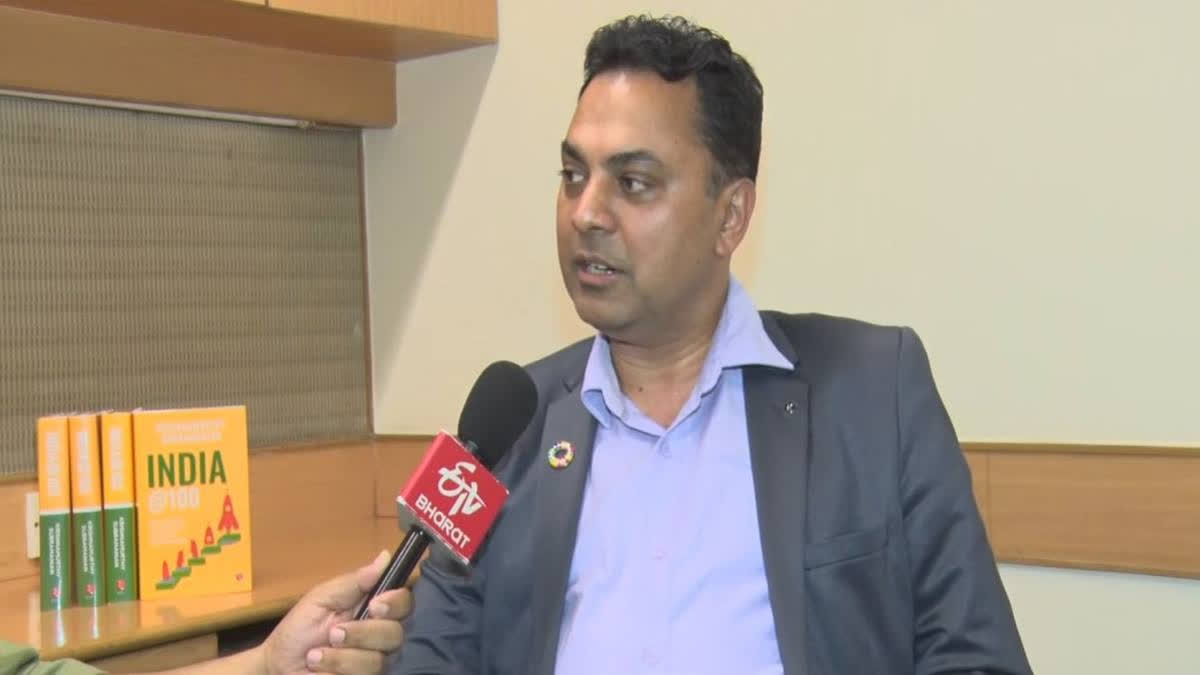New Delhi: The Executive Director of the International Monetary Fund and former Chief Economic Advisor of India Krishnamurthy Subramanian has projected that India will achieve a $55 trillion economy by 2047.
He detailed the calculation method used and remarked, "The data indicates that India's economy is poised to grow at 8 per cent annually until 2047. By the time we mark the centenary of our independence, with controlled inflation, India could reach a $55 trillion economy."
He presented the entire formula to ETV Bharat, which is also outlined in his recent book, India at 100, published by Rupa Publications.
Krishnamurthy Subramanian acknowledged that this target may seem more ambitious compared to other projections, such as Ernst & Young's forecast of a $26 trillion economy by 2047 or Goldman Sachs' estimate of $50 trillion by 2075.
Nonetheless, he noted that early contrarian predictions are often seen as bold. "My projection of a $55 trillion economy by 2047, rather than 2075, is based on meticulous data tracking, a deep understanding of Indian realities, and sound economic reasoning. As a researcher, I follow Sherlock Holmes's principle: 'Never theorize before you have the data,'" he added.
Inflation Will Be the Key
He explained that while the predictions by EY and Goldman Sachs might seem reasonable if we assume the rupee/dollar depreciation will continue as it has over the past three decades, there's a significant shift on the horizon. According to him, two major macroeconomic changes in India are about to alter this pattern.
First, India has introduced an inflation-targeting framework, which mandates the Reserve Bank of India (RBI) to aim for an inflation rate of 4 ± 2 percent. Second, since 2014, the implementation of several structural reforms has greatly boosted productivity growth in the Indian economy. Data from the Penn World Tables — commonly used by economists worldwide —shows that the productivity growth rate, which was 1.3 per cent from 2002 to 2013, jumped to 2.7 per cent starting in 2014. This notable increase is largely attributed to the reform efforts led by the current government, he asserted.
The Formula from the Book
Krishnamurthy Subramanian explains that since India's economic liberalisation in 1991, the country's faster growth compared to the US has led to a modest real appreciation of around 1–1.5 percent per year. However, this appreciation has been largely offset by a higher inflation rate in India compared to the US, which is about 5 per cent. As a result, the rupee has depreciated against the dollar by 3.5 to 4.5 per cent annually over the last thirty years.
Looking ahead, he notes that with the recent major changes — such as the inflation-targeting framework and increased productivity growth — the rupee's annual depreciation is expected to drop to around 0.5 per cent if the GDP can maintain an 8 per cent growth rate.
By using the lower rate of rupee depreciation and assuming an 8 per cent real GDP growth, we can estimate India’s GDP in dollar terms for 2047. According to his research, over the 24-year period from 2023 to 2047, the GDP in dollar terms would double four times, which is equivalent to multiplying it by 16 (2×2×2×2=16). This means the GDP would grow from $3.25 trillion in 2023 to $52 trillion in 2047. However, since the doubling would actually occur approximately every 5.6 years, rather than every six years, the final estimate is expected to be higher — around $55 trillion by 2047.
He mentioned that by 2047, India will be on par with the largest economies of that time, reflecting a status similar to what the country experienced in the 13th or 14th century. On the topic of the growing economy, he emphasised that it will greatly enhance people's lives and incomes. He noted that both the government and private sector are actively engaged in job creation, with an expectation of more high-quality jobs becoming available in the future.
On Jobs
He also discussed India's youthful population, emphasising that job creation will be crucial. He noted that this year's budget’s focus on jobs was positive and could continue in future budgets. He suggested that we should focus on helping small companies grow, as this approach will be key to creating more jobs.
Regarding demographic changes, he pointed out that by 2050, the aging population will increase, particularly in the southern states compared to the northern ones. He stressed that it will be up to these states to ensure the health of their populations and develop the necessary infrastructure. Only with these measures in place can India fully harness its potential on its journey to becoming a $55 trillion economy.



